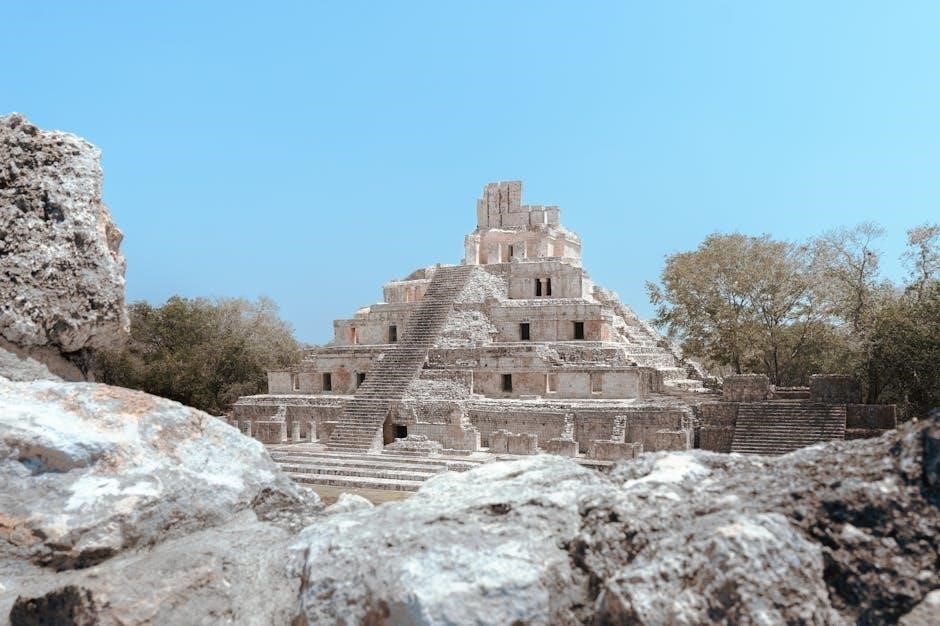Samuel P․ Huntington’s theory proposes that future global conflicts will arise from cultural and religious identities, emphasizing civilization fault lines as battle lines in international relations․
Overview of Samuel P․ Huntington’s Theory
Samuel P․ Huntington’s theory, introduced in his 1993 Foreign Affairs article and expanded in his 1996 book, posits that future global conflicts will primarily arise from cultural and religious divisions․ He argues that civilizations, defined by shared cultural, religious, and historical identities, will become the primary sources of international conflict․ Huntington challenges the notion of a uniform global culture, instead emphasizing the “fault lines” between civilizations as the dominant pattern of future strife․ His work has sparked intense debate, with critics accusing him of oversimplification, while others see it as a provocative framework for understanding global tensions․
Key Themes and Relevance in Global Politics
Huntington’s theory highlights civilization identity as a primary driver of global conflict, emphasizing cultural and religious divisions․ It challenges the idea of a universal global culture, instead focusing on the “fault lines” between civilizations as future battle lines․ His work remains relevant in understanding contemporary geopolitical tensions, offering insights into how cultural differences shape international relations․ Despite criticisms of oversimplification, the theory provides a framework for analyzing conflicts rooted in deep-seated cultural and historical identities․
Core Arguments of Huntington’s Theory
Huntington argues that cultural and religious identities will drive future global conflicts, emphasizing civilization fault lines as primary sources of tension in international relations․
Civilization Identity as a Driver of Conflict
Huntington’s theory emphasizes that cultural and religious identities shape global conflicts․ Civilization identity becomes a primary source of division, as shared values and history create enduring fault lines․ These divisions often lead to mistrust and hostility between civilizations․ Huntington argues that as global politics shifts, civilization identity will replace ideological or economic causes of conflict․ This perspective highlights how cultural differences, rather than political ideologies, will dominate future international relations, making civilization identity a central driver of global tensions and misunderstandings․
The Fault Lines Between Civilizations
Huntington identifies fault lines as the boundaries between distinct civilizations, where cultural, religious, and historical differences create potential conflict zones․ These fault lines often align with geographic and ideological divides, such as those between the West and Islam or Sinic civilizations․ Historical animosities and competing interests exacerbate tensions along these boundaries, making them prone to violence and instability․ As civilizations interact, these fault lines emerge as critical flashpoints, shaping global conflict and cooperation in the post-Cold War world․
The West vs․ the Rest: A Central Divide
Huntington’s theory emphasizes a profound divide between Western civilization and the rest of the world․ He argues that non-Western societies increasingly resist Western dominance, challenging its cultural, political, and economic hegemony․ This divide is driven by historical grievances, cultural differences, and a sense of marginalization․ The West, centered on the United States and Europe, is seen as promoting universal values like democracy and human rights, which are often perceived as imposition rather than inspiration․ This central divide shapes global conflicts, alliances, and the quest for identity in a multipolar world․
Historical Context and Development
Huntington’s theory emerged post-Cold War, addressing shifting global dynamics․ He argued that ideological conflicts would be replaced by civilizational identities, reshaping international relations fundamentally․
From the Cold War to the Post-Cold War World
The end of the Cold War marked a shift from ideological to cultural divisions; Huntington argued that the bipolar world gave way to a multipolar order, where civilizations, defined by shared cultural and religious identities, became the primary sources of conflict․ This transition highlighted the importance of understanding civilizational differences in shaping global politics and alliances, moving beyond traditional state-centric models of international relations․
Huntington’s 1993 Foreign Affairs Article
Huntington’s groundbreaking 1993 article in Foreign Affairs introduced his theory, sparking widespread debate․ He posited that future conflicts would arise from cultural and religious identities, challenging the West’s dominance․ The article outlined civilization fault lines, emphasizing the West vs․ the Rest divide, and predicted clashes along these lines․ This provocative thesis reshaped discussions on global politics, influencing both academic and policy circles, and set the stage for his later book, further expanding these ideas․
The 1996 Book and Its Expansion
Huntington’s 1996 book, The Clash of Civilizations and the Remaking of World Order, expanded his 1993 article, offering a detailed analysis of global conflict dynamics․ The book identified major civilizations, including Western, Islamic, Sinic, and Hindu, and explored their historical and cultural differences․ Huntington argued that these divisions would shape future conflicts, challenging the post-Cold War order․ The book became a seminal work, influencing international relations theory and policy debates, while also facing criticism for oversimplification and cultural determinism․

Major Civilizations Identified
Huntington identifies Western, Islamic, Sinic, Hindu, Slavic-Orthodox, African, and Latin American civilizations as key global entities, each with distinct cultural and historical identities․
Western Civilization
Western Civilization is defined by its roots in Christianity, democracy, and capitalism․ Huntington highlights it as a global powerhouse, shaping international relations through military and economic dominance․ Its values, such as individualism and human rights, often clash with other civilizations․ The West’s influence extends through globalization, but Huntington warns of rising tensions with Islamic and Sinic civilizations․ This civilization’s identity is central to Huntington’s thesis, emphasizing its unique cultural and historical trajectory in shaping global conflict dynamics․ Its legacy remains pivotal in contemporary geopolitical strategies and debates․
Islamic Civilization
Islamic Civilization is characterized by its strong religious identity and adherence to Islamic law․ Huntington identifies it as a major player in global conflicts, often at odds with the West․ Its values, such as community and divine authority, contrast with Western individualism․ The Islamic world’s resistance to Western cultural dominance fuels tensions, particularly along fault lines like the Balkans and the Middle East․ Huntington argues that these divisions will deepen, making Islamic-Western relations a focal point of future clashes, driven by cultural and religious differences rather than ideology or economics․
Sinic (Chinese) Civilization
Sinic Civilization, rooted in Chinese identity and Confucian values, represents a distinct cultural and philosophical tradition․ Huntington emphasizes its historical influence across East Asia, highlighting differences from Western norms․ The rise of China as a global power underscores Sinic Civilization’s growing relevance in international relations․ Its unique governance and societal values contrast with Western democracy, potentially shaping future geopolitical dynamics and cultural exchanges, as Huntington suggests, making it a key player in the clash of civilizations framework․
Hindu Civilization
Hindu Civilization is a cornerstone of Huntington’s theory, representing a unique cultural and religious identity deeply rooted in ancient traditions and spirituality․ Its resilience and philosophical foundations, such as dharma and karma, distinguish it from other civilizations․ Huntington highlights its historical influence and its role in shaping regional dynamics, emphasizing its potential to assert a distinct voice in global politics․ This civilization’s enduring legacy underscores its significance in the contemporary world order and intercivilizational relations․
Slavic-Orthodox Civilization
Slavic-Orthodox Civilization, as per Huntington, is marked by its distinct cultural and religious identity, deeply influenced by Orthodox Christianity․ This civilization’s historical trajectory, shaped by tsarist and Soviet legacies, positions it uniquely between Western and Islamic influences․ Geopolitical tensions, particularly with neighboring powers, underscore its role in global conflicts․ Huntington emphasizes the resilience of Slavic-Orthodox identity in shaping regional dynamics and its potential impact on intercivilizational relations in the modern world order․

African and Latin American Civilizations
African and Latin American civilizations are characterized by their unique cultural, linguistic, and historical contexts․ Both regions exhibit diverse identities, with African civilizations shaped by indigenous traditions and colonial legacies, while Latin America blends indigenous, European, and African influences․ Huntington highlights their distinctiveness in global politics, noting their growing importance in shaping international relations and civilizational dynamics, though often marginalized in broader discussions dominated by major powers․

Criticisms and Controversies
Huntington’s theory has sparked intense debate, with critics accusing it of oversimplification and cultural essentialism․ Some argue it lacks empirical support and risks fostering divisive policies globally․
Accusations of Oversimplification
Critics argue that Huntington’s theory oversimplifies complex cultural and political dynamics, reducing global conflicts to rigid civilizational identities․ Scholars like John R․ Oneal and Michaelene Cox have questioned its empirical validity, suggesting it ignores intra-civilizational diversity and historical nuances․ The theory’s broad categorizations, such as “the West vs․ the rest,” are seen as neglecting the fluidity of cultural interactions․ These criticisms highlight concerns that the theory risks fostering divisive policies by framing civilizations as monolithic and inherently conflict-prone, rather than acknowledging shared humanity and cross-cultural collaboration․
Cultural Essentialism and Determinism
Huntington’s theory has been criticized for promoting cultural essentialism, portraying civilizations as fixed, monolithic entities with unchanging values․ Critics argue this ignores internal diversity and historical evolution․ Determinism is another concern, as the theory suggests civilizational identities predetermine conflict, overlooking agency and cross-cultural cooperation․ This rigid framing fosters stereotypes, reducing complex interactions to simplistic “us vs․ them” narratives․ Such views are seen as dismissive of empirical evidence showing that civilizational identities are fluid and context-dependent, rather than absolute predictors of global conflict․
Empirical Evidence and Validity

Huntington’s theory has faced criticism for lacking robust empirical support․ Studies like the World Values Survey provide some evidence for cultural divides, but critics argue these do not necessarily predict conflict․ The 2000 journal article by John R․ Oneal and Michaelene Cox questioned Huntington’s claims, suggesting his thesis oversimplifies complex interactions․ While Huntington’s ideas resonate with some historical trends, the theory’s validity remains contested, as it often prioritizes cultural explanations over economic or political factors in shaping global conflicts․

Impact and Influence
Huntington’s thesis has profoundly influenced policy debates and academic discussions, shaping perceptions of cultural and civilizational divides, while its real-world applications continue to spark controversy and analysis․
Academic and Policy Debates
Huntington’s “Clash of Civilizations” sparked intense academic and policy debates, with scholars analyzing its implications for global conflict and cultural identity․ While some praised its insightful analysis of post-Cold War dynamics, others criticized its perceived oversimplification of complex interactions․ The theory influenced foreign policy discussions, particularly in understanding civilizational fault lines, though its application often faced criticism for misrepresenting cultural diversity․ Despite controversies, the thesis remains a pivotal framework in international relations, shaping how civilizations navigate modern geopolitical challenges and cultural exchanges․
Real-World Applications and Misapplications
Huntington’s theory has influenced foreign policy and strategic thinking, with some leaders using it to frame geopolitical tensions․ However, its oversimplification of cultural conflicts has led to misapplications, such as justifying unilateral actions or disregarding internal diversity within civilizations․ Critics argue that its rigid framework overlooks the fluidity of cultural identities and the role of economic factors in shaping conflicts․ Despite these criticisms, the theory remains a significant lens for analyzing global dynamics, though its practical application requires careful nuance and context․
Legacy in Contemporary International Relations
Huntington’s theory remains influential in shaping debates on global conflict and cultural identity․ While criticized for oversimplification, it continues to be referenced in discussions on geopolitical tensions and civilizational divides․ The theory’s emphasis on cultural and religious fault lines resonates in contemporary analyses of international relations, particularly in contexts like the rise of nationalism and ideological conflicts․ Despite its controversies, Huntington’s framework provides a lens for understanding complex global dynamics, even as scholars advocate for more nuanced approaches to cultural and political interactions․

Huntington’s thesis remains a significant framework for understanding global conflicts, emphasizing cultural and religious identities as key factors shaping international relations and civilizational interactions․
The Enduring Relevance of Huntington’s Thesis
Huntington’s theory remains influential in understanding global dynamics, emphasizing cultural and religious divides as primary sources of conflict․ His 1993 article and 1996 book sparked intense debate, shaping discussions on civilizational identities and their role in international relations․ Despite criticisms of oversimplification, the thesis continues to be relevant in analyzing contemporary geopolitical tensions, offering insights into the clash of values and interests between major civilizations․ Its impact endures in both academic and policy circles, reflecting its provocative yet enduring contribution to global politics․
Future Prospects for Civilizational Dialogue
While Huntington’s thesis highlights potential conflicts, it also underscores the need for dialogue to mitigate civilizational divides․ Globalization fosters interdependence, creating opportunities for mutual understanding and cooperation․ Encouraging cultural exchange, multilateral institutions, and inclusive policies can help bridge differences․ However, challenges like rising nationalism and ideological rigidities persist․ The future lies in balancing civilizational pride with global collaboration, ensuring that diversity enriches rather than divides the world․ Huntington’s framework remains a cornerstone for exploring these complex dynamics and fostering peaceful coexistence․